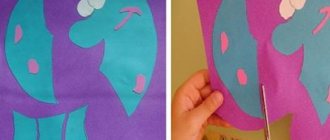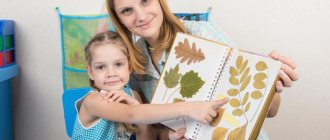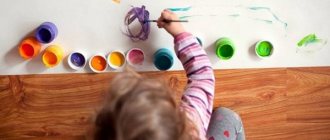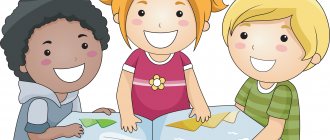Fine arts project in the senior group of preschool educational institutions
Project for senior preschoolers of the preschool educational institution “Colored landscapes”
The author of the project is Zhanna Petrovna Aksenova, teacher of the Borodinsky kindergarten “Teremok”. Objective of the project. To introduce children to landscape painting, to promote their emotional and aesthetic development, to cultivate a kind and caring attitude towards nature and its beauty, and to encourage a warm feeling of love for their land. Bring children joy and inspiration for creativity. One of the directions for creating conditions for personal development is artistic education and development. To form children's ideas about children. It is carried out through the following tasks: 1. To form children’s ideas about landscape painting. 2. Learn to use the acquired knowledge in your own creativity, creating an expressive landscape using appropriate visual materials. 3. Develop creativity and aesthetic taste. 4. Ensure family participation in the educational development of interest in the arts. Project participants: children of senior preschool age, teacher, music director, parents. Implementation period: September-July. “Looking at the beautiful and hearing about the beautiful, a person improves,” - this is what the ancient Greeks said. Therefore, we must surround the child with beauty - everything beautiful we can! Nature can give us everything we need to raise children. How many wonderful sensations and impressions you can get from communicating with nature! How many colors, shapes, sounds, transformations you can see and hear in it! The leading role in the development of a child’s personality and the formation of his spiritual world belongs to the emotional sphere. It is precisely this feature of the psyche of a small person that is associated with the high power of influence of art on him, a phenomenon that is emotional and figurative in its essence. The specificity of fine art, the peculiarities of the language of its various types make artistic activity a unique means of education, teaching a different kind of education and development of the younger generation. In fine arts classes, the natural world acts as a subject of close study and as a means of emotional and figurative influence on the creative activity of students. The proposed system of artistic and creative tasks directs pedagogical work towards the formation in children of holistic ideas about nature as a living organism, which is the essence of environmental and artistic education. A child artist observes nature and expresses his vision of what happens in it through creativity. The teacher helps the child “open his eyes” to the world he sees. Nature can act as an Artist or a beautiful Sorceress who creates the visible world according to the laws of beauty and harmony. Involving artistic and figurative means of other arts: music, painting and literature will help create an atmosphere of the lesson that corresponds to the plan. An artistic landscape reveals the poetry of nature, teaches us to see its beauty, and enriches our ideas. The art of landscape has never been divorced from life, its social laws from man. The richness of content, beauty and diversity of the landscape of our Motherland makes it an important means of aesthetic education of the younger generation. Children are able to perceive the figurative language of art and feel the beauty of nature. But much of the formation and identification of experiences depends on how their aesthetic development is directed and carried out. Landscape painting is one of the most lyrical and emotional genres of fine art; it is the highest level of artistic exploration of nature, inspired and imaginatively recreating its beauty. Introducing children to this genre contributes to their emotional and aesthetic development, fosters a kind and caring attitude towards its beauty, and encourages a sincere, ardent feeling of love for their land, their native land. An artistic landscape helps develop aesthetic taste, imaginative and associative thinking, imagination, and self-contemplation. Landscape painting can not only bring joy, but also inspire creativity. Children and artists know that the best portrait of nature can only be created in co-creation with it. Distribution of activities for the “Colored Landscapes” project Interaction with children: Goal: to instill a love of beauty; enrich the spiritual world; develop imagination; cultivate an aesthetic attitude towards the surrounding reality. Educator: Goal: increasing pedagogical competence in this area, finding ways to implement tasks. Musical director: Goal: to work interconnectedly to create conditions for children to receive a holistic view of the world, opportunities for maximum creative self-expression in any type of activity. Parents: Goal: pedagogical education and involvement in joint creative activities with children. Forms of work. With children:
specially organized activities, games, observations, excursions, viewing reproductions, reading fiction, artistic creativity.
Educator:
Organization of a developmental environment, consultations, workshops, selection of developmental tools (games, literature, exercises, reproductions of paintings).
Music director:
Integrated lessons.
Selection of reproductions of paintings, phonograms of musical works, visual material. Parents:
Consultations, conversations with parents about the importance of this problem, design of travel folders, open classes with children, exhibitions of children's creativity, family creativity.
The topic of the developed project was chosen taking into account the age characteristics of children of senior preschool age and the amount of information that can be perceived by them. The project “Colored Landscapes” consists of mini-projects dedicated to the seasons: “Autumn Melodies”, “Winter Tunes”, “Spring Trill”, “Music of Summer”.
Mini project “Autumn Melodies”.
Observations on walks. Examination of various trees, their structure, shape, color characteristics; observing autumn changes in nature. Target. Learn to recognize and name the signs of autumn. Excursion to the park. Learn to see the beauty of autumn nature by looking at trees and shrubs in autumn decoration. Labor in nature. Collection of natural material; preparing material for work. Target. Show the importance of children's activities. Encourage initiative and independence. Game activity. Didactic games: “Select paints for the artist.” Target. Practice drawing up color combinations on a palette that are close to the color scheme of the painting. "Collect a landscape." Target. Learn how to compose an autumn landscape according to your own plans. Introduction to fiction. Learning poems about autumn: V. Avdienko “Autumn”, A. Pleshcheev “A boring picture...”, I. Bunin “Falling Leaves”. Reading the story by M. Sokolov-Mikitov “Autumn in the Forest.” Target. To develop children's interest in fiction. Improve children's ability to read poems expressively. Getting to know art. Examination of reproductions of paintings: I. Levitan “Golden Autumn”, I. Ostroukhov “Golden Autumn”, E. Volkova “October”, I. Ostroukhov “Autumn”, I. Brodsky “Autumn Leaves”. Target. Encourage children to admire the beauty of nature and the paintings created by artists. Children's artistic creativity. Drawing on the themes: “Forest in autumn dress”, “Golden autumn”, “Autumn can be different”, “Late autumn”. Target. Learn to reflect autumn impressions in a drawing, convey its color. Application of autumn leaves: herbarium - horoscope “Zodiac Signs”. Target. Develop teamwork skills. Develop a sense of composition. Integrated lesson: “Waltz of Autumn Leaves” Purpose. To teach to perceive images of nature conveyed in poetry, music, and fine arts. Artistic work. Collective work on the production of the book “Four Artists”. Target. Develop the ability to think about the content of your work, work together to bring what you start to the end. Develop creativity. Making a landscape composition from natural material and plasticine “Seasons - Autumn”, “At the Forest Edge”. Target. Develop children's creativity, imagination, imagination. Learn to conceive a plot, take into account the opinions of others.
Mini project “Winter tunes”.
Observations on walks. Observations of winter phenomena in nature: the color of snow, sky, trees covered with snow. Excursion to the park. Looking at winter landscapes. Target. Learn to notice changes occurring in nature. Introduction to fiction. Learning poems: A. Pushkin “The winter sorceress is coming”, S. Yesenin “Winter is singing and calling out”, I. Surikov “White fluffy snow”. Reading the story by V.V. Volin “What snow can be like.” Target. To develop in children a creative approach to depicting the world around them through poetic works about nature. Game activity. Conducting didactic games: “Artists restorers.” Target. To develop children's creative imagination, the ability to compose a winter landscape from parts according to a model. “I see - I finish drawing” Goal. Develop children's creative imagination. Getting to know art. Examination of paintings: I. Grabar “The Tale of Frost and the Rising Sun”; I.I. Shishkin “Winter”; A.K. Korovin “In Winter”; A. Plastov “First Snow”. Target. Evoke an emotional response to the artistic image of a winter landscape; develop artistic perception of landscape paintings. Children's artistic creativity. Drawing on the topics: “The forest slumbers under the fairy tale of sleep”; “What is it like, winter - winter?”; Modeling “Winter day”. Application and drawing “Blue winter evening and moonlit winter night.” Target. Develop artistic skills. the ability to conceive a landscape and find means of expression to create an image of nature. Integrated lesson “What kind of winter is it?” Target. To develop the ability to give aesthetic assessments, to correlate judgments by mood, images of painting, music, poetry, and works of art. Artistic work. Continue collective work on the production of the book “Four Artists” (drawing, appliqué). Drawing up a landscape composition from natural material “Seasons - winter”.
Mini project “Spring Trill”.
Daily weather observations. Observations of the color of the sky, the sun, melting snow, the awakening of trees and bushes from winter sleep. Excursion to the park. Looking at spring flowers - snowdrops, coltsfoot; examination of the spring attire of trees and bushes, the color of the leaves. Target. Develop the ability to notice and name changes occurring in nature. Clarify children's ideas about the signs of spring. Introduction to fiction. Learning poems: A. Pleshcheev “The grass is turning green...”; A. Pushkin “Driven by the spring rays...”; F. Tyutchev “Spring Waters”; A. Maikov "Spring". Reading the story by V.V. Volin “Blue Streams of Spring.” Target. Enrich and diversify the content of children's drawings through poetry and stories about nature. Game activity. Game "Picture Gallery" Goal. Learn to look at pictures, see the main thing; distinguish landscapes from other types of painting; develop memory, attention, thinking. Game "Find the painting from the sketch." Target. Develop integrity of artistic vision; establish the relationship between phenomena and objects in a linear perspective. Getting to know art. Examination of paintings: A.K. Savrasov “The Rooks Have Arrived”; I.I. Levitan “Spring. Big water"; A.A.Rylov “Green Noise”. Target. Form ideas about landscape painting. To develop the ability to see the unity of content and means of artistic expression of painting. Children's artistic creativity. Target. To cultivate emotional responsiveness to the beauty of the surrounding nature and art. Introduce various ways of creating an artistic image (literature, music, visual arts). Drawing on the themes: “Early spring”; “Spring has come, freckle, spring guest”; "Tender Spring"; “The first flowers have already appeared in the spring thawed patches”; "There's a green noise going on." Modeling on the themes: “Spring has come”; "Blossoming Spring"; Target. To evoke a response in children to the joyful revival of nature in spring. Learn to use the acquired knowledge in your own creativity, creating an expressive image of the coming spring. Integrated lesson: “Spring fantasies.” Target. To cultivate emotional responsiveness to the beauty of the surrounding nature and art. Introduce various ways of creating an artistic image (literature, music, visual arts). Artistic work. Collective production of the book “Four Artists” (drawing, appliqué). Drawing up a landscape composition from natural material “Seasons - spring”.
Mini project “Music of Summer”.
Daily observations while walking.
Observations of the sun, sky and clouds, wind, rain, thunderstorms and rainbows, trees and shrubs, plants. Target. Give an idea of the weather conditions in summer. Targeted walk to the meadow. Consider the plants, what color they are, their shape, talk about their structure, the benefits of flowers. Target. Introduce flowering herbaceous plants. Introduction to fiction. Learning poems: S. Yesenin “Good Morning”; I. Nikitin “A Rainbow Shines in the Sky”, “Wonderful Summer Day”; F.I. Tyutchev “Summer Evening”. Target. To cultivate a love of nature through landscape poetry and prose. Game activity. Game "Excursion to the Museum". Target. Learn to express your attitude to the picture, express your opinion, explain your choice. Game "What's extra." Target. To consolidate knowledge about landscape and the ability to distinguish it from other genres. Getting to know art. Examination of paintings: “Rainbow” by A.K. Savrasov, A.I. Kuindzhi, I.I. Shishkin “Rye”, “Birch Grove”, “Morning in a Pine Forest”, F. Vasiliev “Wet Meadow”. Target. Learn to analyze works of landscape painting, to see the unity of the artist’s plan and the means of expression he found. Children's artistic creativity. Drawing on the themes: “Summer has come”, “Red Summer”, “Summer Landscape”, “Colors of Summer”. Modeling: “Blossoming meadow”. Entertainment “Summer, oh summer!” Target. Give children the joy of meeting with a poetic, musical, visual image. Artistic work. Collective work on the production of a book about landscapes “Four Artists” (drawing and appliqué). Compiling a composition from natural material “Seasons - Summer”. During the year, we examined all the seasons: characteristic features, features. Children observed nature and embodied their knowledge gained from this in projects. In the process of working on this project, children were engaged in productive activities aimed at developing coherent speech, based on means of developing fine motor skills: modeling, appliqué, drawing. And the children experienced a variety of feelings: they were happy about the beautiful image that they themselves created, they were upset if something didn’t work out. But most importantly; By creating a collective project, children acquired various knowledge; clarified and deepened ideas about the world around us. In the process of work, they began to understand the properties of objects, remember their characteristic features and details. In the course of work, children acquired knowledge and skills that facilitate children’s assimilation of specific information about plants, animals, and natural phenomena, allowing them to instill in them environmental skills and respect for the environment and the natural world. Children developed research skills, developed cognitive activity, independence, creativity, and communication. All this contributes not only to the knowledge of the beautiful in nature, but also in oneself, the affirmation of human dignity, kindness, empathy for all living things, interest in the surrounding world, natural phenomena; understanding of the uniqueness of living things, practical skills in humane treatment of them. Using the project method in working with preschoolers helps to increase the child’s self-esteem. By participating in the project, the child feels significant in a group of peers, sees his contribution to the common cause, and rejoices in his successes. The project was implemented in a playful way with the inclusion of children in various types of creative and practically significant activities, in direct contact with various objects of the surrounding society (excursions, games on objects of the social environment, practically useful activities). In the future, work on this project will be complicated and continued. During this time, we all learned about the world, made discoveries, were surprised, disappointed, made mistakes, corrected them, and gained experience in communication. But each of us walked the path of discovering the unfamiliar, previously unknown, and together we did one thing: we studied and taught each other. Despite my teaching experience, I am convinced every time that repetition is impossible. Each child is unique, and what we do as teachers is unique, we cannot and will not be able to do what we have already done with previous children. All that remains is experience and knowledge. Why repeat? A new fairy tale, a new game, a new discovery of a wonderful world in bright, living colors will come to open the way to the heart of a little inquisitive, tireless explorer. Exhibitions of children's works Homemade book “Four Artists” Compositions made from natural materials
We recommend watching:
Project in kindergarten for older preschoolers 5-7 years old on legal topics Project in the senior group of kindergarten Project in the senior group on the topic “Trees and shrubs in spring” Project in the senior and preparatory group of the kindergarten
Similar articles:
Project for children of the senior group “Our cheerful garden”
Creative project in fine art in the senior group Miracles and only (5-6 years old)
Creative project in the senior group using
methods and techniques of unconventional drawing
“Miracles and nothing more”
Author of the project: O. G. Krivko, 2016.
Implementation period: October-April.
Project participants: children of the senior group, teacher, parents.
Type of project: long-term, group, long-term.
Relevance of the project:
Drawing is an interesting and useful activity in which pictorial and graphic images are created in a variety of ways using a variety of materials. A child creates according to his age.
Project goal: To study the process of development of creative abilities in children of senior preschool age through non-traditional drawing.
Objectives: Select specific forms of non-traditional drawing according to the age of the children.
To study the development of children's creative abilities while using methods and techniques of non-traditional drawing.
Help children master various technical skills when working with non-traditional techniques.
To develop children's aesthetic sense of form, color, composition.
Develop creativity and imagination.
Practical part
Finger painting
Means of expression: spot, dot, short line, color.
Materials: bowls with gouache, thick paper of any color, napkins.
Method of obtaining an image: the child dips his finger in the gouache and puts dots and specks on the paper. Each finger is painted with a different color.
Palm drawing
Means of expression: spot, color, fantastic silhouette.
Materials: wide saucers with gouache, brush, large format sheets, napkins.
Method of obtaining an image: the child paints his palm with a brush and makes an imprint on paper.
Impression with cork
Means of expression: stain, texture, color.
Materials: a bowl or plastic box containing a stamp pad made of thin foam rubber impregnated with gouache, thick paper, cork seals.
Method of obtaining an image: the child presses the cork to a staple pad with paint and makes an impression on the paper.
Potato stamp imprint
Means of expression: stain, texture, color.
Materials: a bowl with a foam pad soaked in gouache, paper, potato stamps.
Method of obtaining an image: the child presses the signet to the stamp pad and makes an imprint on thick paper.
Imprint with crumpled paper
Means of expression: stain, texture, color.
Materials: a saucer containing a foam rubber stamp pad soaked in gouache, thick paper, crumpled paper.
Method of obtaining an image: the child presses the crumpled paper to the stamp pad and makes an impression.
Subject monotype
Means of expression: spot, symmetry, color.
Materials: thick paper of any color, brushes, gouache or watercolor.
Method of obtaining an image: the child folds a sheet of paper in half and draws half of the depicted object on one half. After drawing, until the paint has dried, the sheet is folded in half to make a print. The missing details are completed.
Blotography with a tube
Means of expression: stain.
Materials: paper, thinly diluted gouache in a bowl, plastic spoon, drinking straw.
Method of obtaining an image: the child scoops up paint with a plastic spoon, pours it onto the sheet, making a small spot. Then blow on this stain from a tube so that its end does not touch either the stain or the paper. The missing details are completed.
Wax crayons + watercolor
Means of expression: stain, texture, color.
Materials: wax crayons, thick white paper, watercolor, brushes.
Method of obtaining an image: the child draws with wax crayons on white paper. Then he paints the sheet with watercolors in one or more colors. The chalk drawing remains unpainted.
Methods and techniques for implementing the project: conversation, looking at illustrations, memorizing poems, experimenting, productive activities.
Expected results: identification and awareness by the child of his abilities. Children's speech is enriched. Fine motor skills of the hands, thinking, imagination, and positive emotions when asked to draw develop.




